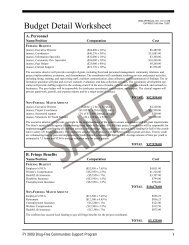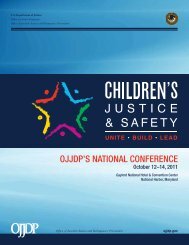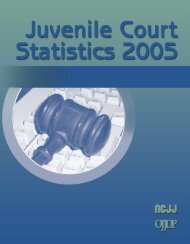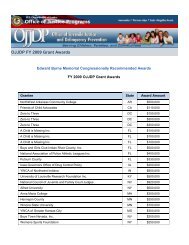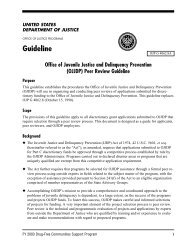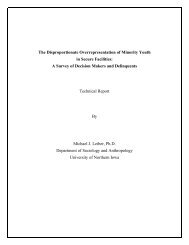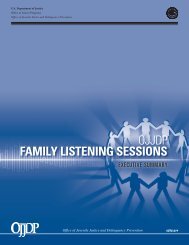Enforcing Underage Drinking Laws Assessment, Strategic Planning ...
Enforcing Underage Drinking Laws Assessment, Strategic Planning ...
Enforcing Underage Drinking Laws Assessment, Strategic Planning ...
Create successful ePaper yourself
Turn your PDF publications into a flip-book with our unique Google optimized e-Paper software.
o a high degree of participation and coordination among alcohol beverageenforcement agencies and state, county, municipal, and tribal law enforcementagencies, such as through law enforcement task forces.• have alcohol beverage enforcement agencies and law enforcement professionalsserve as liaisons with local chapters of police organizations and associations thatrepresent diverse groups, helping to enhance coordination and participation, andimprove collaboration of enforcement efforts.• deploy enforcement resources based on the identification of underage drinkingproblems, particularly in locations where underage drinking most often occurs.• conduct highly visible underage drinking enforcement that maximizes contactbetween officers and the underage drinkers and widely publicize these efforts—before, while, and after they occur.• coordinate efforts with alcohol beverage enforcement officials (see section II.A.,Responsible Alcohol Service).• use technology to enhance law enforcement efforts (e.g., video equipment, devicesto detect alcohol in breath and saliva, and mobile data terminals).• require that alcohol beverage enforcement officers and law enforcement officersinvolved in enforcing alcohol laws receive state-of-the-art training in the latest lawenforcement techniques and emerging technologies.• expedite the custodial or arrest process (e.g., by reducing paperwork and processingtime from the time of arrest to booking and/or release).• measure success emphasizing quantitative data, including the level of effort (e.g.,number of participating agencies, checkpoints conducted, arrests made), publicawareness (e.g., of message and actual enforcement), reported change in behavior(e.g., number of underage drinkers), and outcomes (e.g., alcohol-related fatalitiesand injuries caused by underage drinkers).C. Publicizing High-Visibility EnforcementStates should actively communicate their underage drinking law enforcement efforts toincrease the public’s perception of the risks of detection, detention, arrest, prosecution,dispositions, and sentencing. Publicity should be culturally relevant, appropriate to theaudience, and based on market research. States should:• focus on creating a perception of the risk of detection, detention, arrest, prosecution,sanctions, dispositions, and punishment for underage drinking.• develop and implement a year-round communication plan that includes:o messages coordinated with national campaigns;OMB No. 1121-0329Approval Expires 02/28/201326OJJDP FY 2011 EUDL <strong>Assessment</strong>, <strong>Strategic</strong> <strong>Planning</strong>, and Implementation InitiativeOJJDP-2011-2997


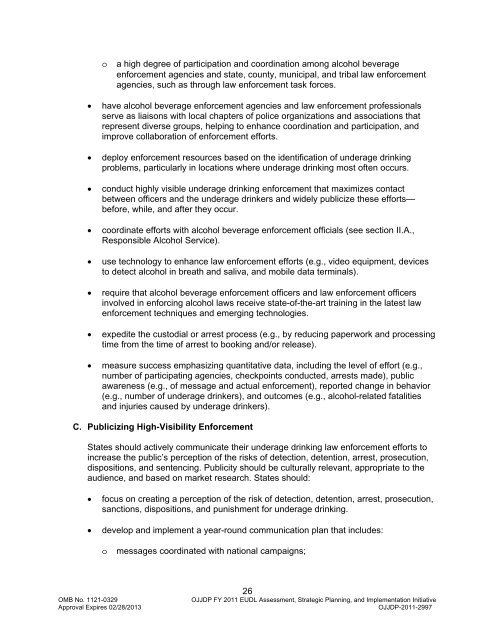

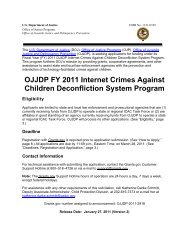
![Chapter 5 [PDF] - Office of Juvenile Justice and Delinquency ...](https://img.yumpu.com/46584340/1/190x245/chapter-5-pdf-office-of-juvenile-justice-and-delinquency-.jpg?quality=85)
